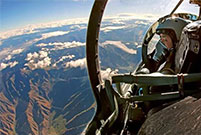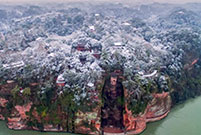

SEOUL, Feb. 3 -- South Korea on Wednesday warned a harsh price against possible launch of long-range ballistic missile by the Democratic People's Republic of Korea (DPRK) following Pyongyang's notification of its plan to launch a satellite into orbit.
"If North Korea (DPRK) pushes ahead with long-range missile launch, it will pose a significant threat to peace and security in the region and the world as well as on the Korean Peninsula," said Cho Tae-Yong, the first deputy chief of the presidential security office.
Cho said that Seoul sternly warns a harsh price, which will come from the international society, against Pyongyang.
The DPRK had informed the International Maritime Organization and the International Telecommunication Union of its plan to put what it called a Kwangmyongsong earth-observing satellite into orbit between Feb. 8 and 25.
The satellite launch was widely expected in South Korea as the DPRK blasted off long-range rockets to carry satellites months before or after its previous nuclear tests in 2006, 2009 and 2013 each. The DPRK claimed on Jan. 6 that it tested its first hydrogen bomb.
Pyongyang launched the three-stage Unha-3 rocket, carrying what it called the Kwangmyongsong-3 satellite, on Dec. 2012, two months before its third atomic bomb test. At that time, Seoul and Washington called it the test-launch of long-range ballistic missile, violating the UN Security Council resolutions.
Cho urged the DPRK to immediately drop the missile launch plan as it clearly violates UN resolutions, saying that Pyongyang's notification of long-range missile launch, despite the ongoing discussion on UN sanctions against its fourth nuclear test, was a blatant challenge to the international society.
The DPRK is banned from test-firing any rockets based on a ballistic missile technology under UN Security Council resolutions. South Korea's military strengthened the monitoring of the DPRK's main rocket launch station after its nuclear detonation in early January.
The DPRK had covered the roof of a launch pad for rockets with screens at its main rocket base at Tonchang-ri in the northwest region, where the Unha-3 rocket was launched in December 2012. The covering presumably aimed to hide possible preparations for another rocket launch, sources said.
The rocket base is believed to have equipped itself with automated facilities of assembly and transport for rocket projectiles that can be moved in the two-lane rails inside the launch site.
Railroad tracks between the rocket base and the Tonghchang-ri railway station have been also fence-screened to cover up the moves of rocket projectiles, manufactured in a factory in Pyongyang.
The South Korean military had recently detected the moves of vehicles and personnel at the rocket base, signs of the DPRK's another rocket launch. The DPRK completed construction in 2015 to expand the launch tower, with its height being raised from 50 meters to 67 meters.
The Unha-3 rocket was about 30 meters long, estimated to have a range of about 10,000 km that can strike parts of the U.S. mainland. The South Korean military estimated that the DPRK developed a rocket that can fly around 13,000 km.
The DPRK is believed to have deployed about 2,000 ballistic missiles, including Scud missiles with a range of 300-700 km and Rodong missiles ranging some 1,300 km.
 Have you ever taken these beautiful subways in China?
Have you ever taken these beautiful subways in China? Chinese beauties, foreign models meet in Chengdu
Chinese beauties, foreign models meet in Chengdu Awesome! Aerial pictures taken on J-11 fighter
Awesome! Aerial pictures taken on J-11 fighter A foreign girl explains what China should be proud of
A foreign girl explains what China should be proud of Chinese navy's air-cushioned landing craft in pictures
Chinese navy's air-cushioned landing craft in pictures Chinese pole dancing master opens class in Tianjin
Chinese pole dancing master opens class in Tianjin Splendid Sichuan after snow
Splendid Sichuan after snow College girl of Vancouver crowned Miss Chinese Int'l 2016
College girl of Vancouver crowned Miss Chinese Int'l 2016 Pentagonal Mart becomes the largest vacant building in Shanghai
Pentagonal Mart becomes the largest vacant building in Shanghai Top 20 hottest women in the world in 2014
Top 20 hottest women in the world in 2014 Top 10 hardest languages to learn
Top 10 hardest languages to learn 10 Chinese female stars with most beautiful faces
10 Chinese female stars with most beautiful faces China’s Top 10 Unique Bridges, Highways and Roads
China’s Top 10 Unique Bridges, Highways and Roads Buying nianhuo!
Buying nianhuo! What Chinese try to sneak on flights (and how)
What Chinese try to sneak on flights (and how) Northeast authorities vow they will work to eradicate GM grains
Northeast authorities vow they will work to eradicate GM grains China’s richest village manages to transition away from old industries
China’s richest village manages to transition away from old industriesDay|Week